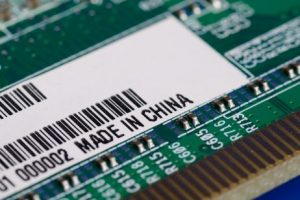Water With Your Chips? Semiconductors and Water Scarcity in China
Everyone knows it’s a bad idea to spill water on a cell phone, but did you know that it takes more than 3,000 gallons of water to produce one? Water is needed for mining the metal, making the glue and plastic for assembly and packaging, and then diluting the wastewater used throughout the process. This amount is 10 times the average per capita daily water consumption in China.
Semiconductors, the tiny circuits known as chips that power all of our electronic devices — including your phone — are particularly thirsty. Each 30 cm integrated circuit board that holds the chips in your phone requires at least 2,000 gallons of H2O to produce. This is because each chip needs to be rinsed with ultrapure water (UPW) — water so pure that is considered an industrial solvent — to remove debris (ions, particles, silica, etc.) from the manufacturing process and prevent the chips from becoming contaminated. It takes 1,400-1,600 gallons of tap water to make 1,000 gallons of UPW.
Semiconductors are now a key focal point of China-U.S. geopolitical competition. If data is the new oil and artificial intelligence (AI) is the new electricity, then it make sense to view semiconductors as a global resource generating risks in the same way as any other resources. We also need to keep in mind the water resources that are required to manufacture them.
While China only accounts for 7.6 percent of semiconductor sales, its planned massive investment in the sector ($150 billion from 2014 to 2030) has raised concern about a “Sputnik moment“ over China’s determination to achieve technological greatness. Despite this surge in funding, water availability represents an important constraint, as semiconductor production requires considerable water resources which China lacks, especially in areas where chip manufacturing is concentrated.
China’s Risk
The water requirements of semiconductor production thus far have not been raised as a key concern in China, which has been focused on developing domestic technologies to reduce reliance on global supply chains. Even before China-U.S. trade tensions heightened during the Trump administration, China’s 2025 initiative, announced in 2015, outlined steps to develop a domestic semiconductor capability sufficient to meet 70 percent of domestic production needs. While a relative latecomer to the sector, a July 2021 study by the Semiconductor Industry Association notes that China is catching up fast thanks to government funding, subsidies, and tax benefits for the sector. The newly released 14th Five Year Plan (2021-2025) identified semiconductors as one of the top priority “frontier technologies,” which the Chinese State Council outlined a whole-of-government approach to develop.
Nevertheless, even with $150 billion committed under the 2014 National Integrated Circuit Plan, China faces significant technological hurdles to produce the high-end chips needed for mobile phones, laptops, and other high-tech goods. Experts foresee mixed success for China — its companies will lag in certain areas such as cutting-edge foundry process technology and materials while achieving competitiveness in outsourced assembly and testing (OSAT) and chip design.
Fuente:Water With Your Chips? Semiconductors and Water Scarcity in China – The Diplomat


